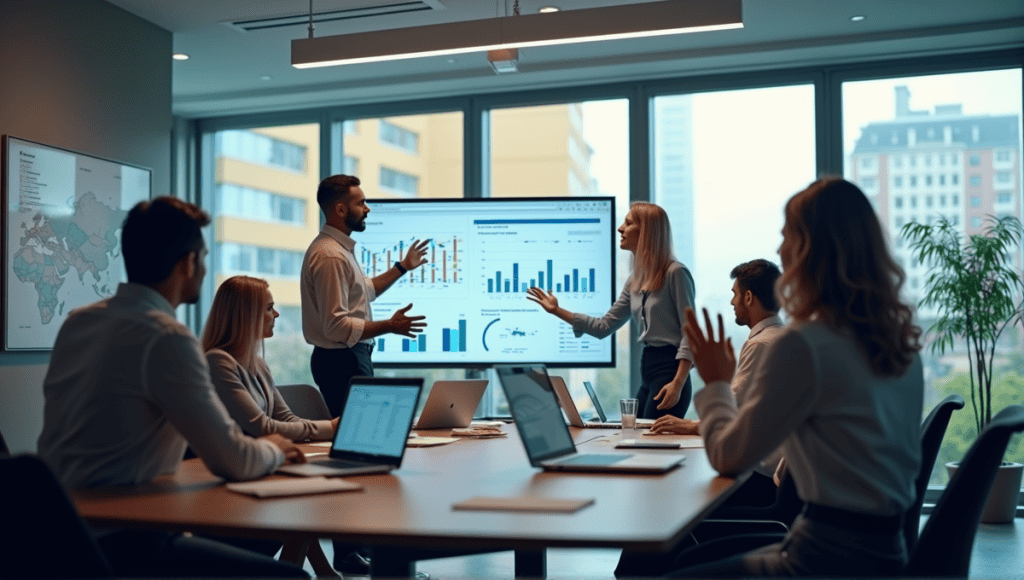As a former industrial engineer turned lean management consultant, I’ve worked with many businesses that grapple with the efficiency vs. effectiveness conundrum.
It’s an important differentiation, as understanding it correctly can significantly impact your business processes. So in this post, I’ll outline the main differences between efficiency and effectiveness and how you can use both to ensure your business operates at peak performance. You’ll also discover actionable tips to increase your productivity while still producing high-quality work.
Defining Efficiency and Effectiveness

Efficiency and effectiveness are two important business concepts that are often conflated. In my career, I’ve encountered many businesses that struggle to distinguish between the two concepts. Let’s break it down.
Efficiency is doing things right. It is using resources judiciously to complete tasks with minimal waste. When you’re efficient, you are optimizing time, money, and effort.
Effectiveness, on the other hand, is doing the right things. It’s about obtaining the desired result and accomplishing an objective. An effective strategy delivers the results you’re seeking.
The key differences between efficiency and effectiveness are:
- Focus: The process (efficiency) vs. the outcome (effectiveness)
- Measurement: Quantitative (efficiency) vs. often qualitative (effectiveness)
- Time horizon: Short-term (efficiency) vs. long-term (effectiveness)
- Resource utilization: Minimizing resources (efficiency) vs. maximizing impact (effectiveness)
In business, these concepts are interconnected. You need both. An efficient process that doesn’t help you accomplish your goals isn’t helpful. Similarly, being effective without efficiency will likely waste resources.
For example, I once consulted with a manufacturing plant that was producing widgets faster than anyone else. The process was incredibly efficient. However, their widgets weren’t what customers wanted. The company was efficient (doing things right) but not effective. We had to change their processes to focus on quality and what customers wanted.
The key is finding the balance between efficiency and effectiveness. You want to achieve your goals (effectiveness) while using resources judiciously (efficiency). This balance is what leads to sustainable success in any business venture.
Measuring Efficiency
Tracking efficiency is key to making continuous improvements. I’ve used various efficiency tracking methods across industries. Here’s what I’ve discovered.
The most common Key Performance Indicators (KPIs) to track efficiency include:
- Productivity rates
- Cycle time
- Resource utilization
- Cost per unit
- Waste eliminated
Calculate efficiency differently depending on the industry. For manufacturing, we use output / input. For service industries, you might use tasks completed / hour. The key is to quantify how effectively resources are being used.
Efficiency largely ties back to time and resource management. I always stress the importance of tracking how much time you spend on each task. And it reveals where a process is breaking down and how to fix it.
Avoid these common missteps when tracking efficiency. Don’t exclusively optimize for speed if it sacrifices quality. Focusing too much on a single efficiency metric often backfires. For example, a call center optimized for the shortest call duration and their efficiency numbers improved. However, customer retention plummeted.
Keep in mind that your efficiency metrics should support broader business objectives. They are a means to an end (improving the process), not the end itself.
Measuring Effectiveness
Measuring effectiveness is a bit more challenging than efficiency because you’re evaluating the results rather than the operations themselves. Here are a few tips from my experience.
Common KPIs for effectiveness include:
- Customer satisfaction scores
- Market share
- Revenue growth
- Employee engagement
- Brand recognition
Effectiveness measurements can be both quantitative and qualitative. For example, revenue growth is a quantitative measure, whereas survey data is qualitative.
The biggest challenge with measuring effectiveness is that many of these outcomes are long-term and it’s hard to isolate the impact your company has on these results. Additionally, much of the data you collect for effectiveness is qualitative, making it more subjective.
Each industry will have different primary effectiveness measures it cares about. For example, in a factory, the primary effectiveness measures may be product quality and market share. For a marketing agency, it may be campaign ROI and brand recognition.
In my experience, combining multiple measures is the best approach. You rarely want to rely on a single measure, so the balanced scorecard method might be the best way to capture multiple angles of effectiveness.
Regular stakeholder feedback is key. Whether it’s surveys, interviews with your market, or focus groups with your customers, use these qualitative inputs to back up your quantitative data.
Just make sure that your effectiveness measurements align with your strategic goals so you can ensure you’re making progress toward your long-term goals.
Balancing Efficiency and Effectiveness

Balancing efficiency and effectiveness is truly an art. It’s a challenge I’ve encountered at all of the organizations I’ve been a part of. Here are a few key insights.
The equilibrium between efficiency and effectiveness is essential. If you optimize strictly for efficiency, you might sacrifice quality. If you optimize exclusively for effectiveness, you’ll waste resources. The answer lies somewhere in between.
When to prioritize efficiency:
- Tasks that are repetitive
- Any type of production work at scale
- Operations with a cost focus
- Processes with time sensitivity
When to prioritize effectiveness:
- Anything related to strategy
- Managing customer or user relationships
- Innovating, which includes R&D
- Managing a crisis
How to optimize for both:
- Build a culture of continuous improvement
- Use data to make all decisions
- Create a culture of innovation
- Invest in ongoing employee training and development
- Consistently review and adjust your goals
For example, I worked with one software company that optimized for efficiency and releasing as many features as quickly as possible. This resulted in efficiency and ineffective products. We switched to optimizing for user research and efficiency, and the team spent time user testing. While the development process was slower, the product was far more effective.
So remember, you want to be both efficient and effective. It’s not about one or the other, but the right mix for your context.
Efficiency vs Effectiveness in Project Management
In project management, balancing efficiency with effectiveness is key. I’ve seen projects tank because there wasn’t a balance of these two things.
Efficiency in project management typically involves:
- Meeting deadlines
- Staying on budget
- Optimizing resources
On the other hand, effectiveness in project management includes:
- Meeting project objectives
- Creating value for the project stakeholders
- Ensuring the project is high quality
The consequence of optimizing for one at the expense of the other is often a failed project. If you optimize for efficiency, the project will likely run out of resources. If you optimize for effectiveness, you could produce something high quality that’s very delayed.
For example, I worked on a construction project where the initial priority was to be quick. We optimized for efficiency, but the quality was very low. As a result, we needed to redo several components of the project, which ultimately took more time and resources. In hindsight, we optimized the process to be efficient, but also built in steps to ensure quality. The project finished slightly later than anticipated, but the quality was significantly higher and the stakeholders were much happier.
Here are some of the most common mistakes I see:
- Focusing on just completing tasks—regardless of whether those tasks create value
- Ignoring communication with stakeholders in favor of speed
- Following the plan too strictly without any change management
All of the most successful projects I’ve worked on had a balance of both. They both delivered on time and on budget and also met stakeholder expectations (or exceeded them).
Efficiency vs Effectiveness in Operations Management

Operations management is the intersection of efficiency and effectiveness. I’ve seen this concept play out in factories, warehouses, and service centers.
Efficiency in operations refers to:
- Streamlining processes
- Minimizing waste
- Maximizing resource utilization
Meanwhile, effectiveness refers to:
- Meeting customer demand
- Ensuring product quality
- Adapting to market changes
Lean management principles balance both concepts. It aims to eliminate waste while also delivering customer value. It’s not just about doing things faster, but doing the right things faster.
In supply chain management, efficiency might look like optimizing inventory levels. Effectiveness means having the right products at the right time. You need both to succeed.
Efficiency Key Strategies
- Process automation
- Just-in-time inventory
- Standardized procedures
- Data-driven optimization
Effectiveness Key Strategies:
- Customer feedback loops
- Quality control measures
- Flexible production systems
- Employee empowerment
Just remember, emergency work is always three to four times more expensive than planned work. This is why balancing efficiency with being effectively planned and proactive is important.
For example, I once worked with a food processing plant to improve operations. We installed efficient production lines while also ensuring product quality and market changes. As a result, we increased productivity by 30% and customer satisfaction by 20%.
Efficiency vs Effectiveness in Financial Management
Financial management is finding the right tradeoff between efficiency and effectiveness. I’ve observed this in companies of all sizes.
Efficiency metrics in finance might include:
- Cost reduction percentages
- Transaction processing times
- Return on investment (ROI)
Examples of effectiveness metrics in finance include:
- Financial forecast accuracy
- Investment strategy success rate
- Long-term financial stability
Balancing cost reductions (efficiency) with investments (effectiveness) is another key concept. If you only focus on saving money, you will miss out on growth opportunities. If you only focus on spending money, you’ll put the business at financial risk.
For example, I worked with a retail chain that was extremely efficient as they were constantly saving money. However, they were so focused on cost-cutting that they rarely invested back into the company. As a result, the stores went outdated, sales declined, and the business lost market share.
We shifted their focus to investing back into the business (store renovations and employee training), which required spending money. This was a short-term cost increase, but it led to long-term revenue growth. As they shifted from cost saving (efficiency) to investing back into the business (effectiveness), they saw great results.
Spend efficiency is another metric you can calculate by dividing total annual spend by RAV (replacement asset value) or ERV (equipment replacement value). This allows you to balance between efficient spending on maintenance and effective long-term spending on asset management.
Remember that efficient financial processes should drive effective financial strategies. It’s not just about saving money. It’s about wisely using resources to achieve long-term financial goals.
Technology’s Role in Enhancing Efficiency and Effectiveness

Technology has changed the game in terms of efficiency and effectiveness. I’ve seen this shift in nearly every industry.
Digital tools and automation have made businesses more efficient. Many processes that used to take hours can now be completed in minutes. For example, automation within an inventory system makes supply chain operations more efficient by reducing errors and saving time.
Data analytics has made businesses more effective by providing more insights. As a result, businesses can make more data-driven decisions. I’ve seen marketing campaigns perform significantly better thanks to data-driven insights on the target audience.
The key is finding the right balance between technology and human expertise. Technology should enhance human skills, not replace them entirely. For example, in a manufacturing plant, we used AI to manage quality control. It made the system significantly more efficient, though we still had humans managing the AI to make more complex decisions.
To ensure technology is as effective as possible, it should:
- Have clear alignment to a business goal.
- Offer adequate user training.
- Integrate with other systems to maintain consistency.
- Have processes to continuously evaluate and refine it.
I also helped a healthcare business implement electronic health records. Initially, it made the process less efficient as employees adjusted. However, in the long run, it made both efficiency (faster access to patient information) and more effective (better coordinated care).
Remember, technology is just a tool: it’s not the solution. It’s only as valuable as how well it helps you achieve a business goal and enhance a human skill.
Training and Development for Efficiency and Effectiveness
Training is one of the most effective strategies to improve both efficiency and effectiveness. I’ve witnessed well-designed training programs completely turn around organizations.
Skills that contribute to efficiency:
- Time management
- Process efficiencies
- Technical skills
- Ability to multitask
Competencies that contribute to effectiveness:
- Strategic thought
- Problem solving
- Communication skills
- Adaptability
The trick is designing training programs that address both efficiency and effectiveness. To do this, I recommend:
- Combining technical skills and soft skills training
- Using real examples of scenarios in your training
- Encourage the mindset of always learning and improving
- Cross training opportunities
It’s also important to measure the impact of your training on the organization. To do this, look at:
- Improvement in productivity
- Reduction in error rates
- Increases in customer satisfaction
- Employee engagement scores
For example, I once consulted with a call center to overhaul their training program. We delivered training on both efficiency-driven topics (ex. call handling) and effectiveness-driven (ex. customer empathy and deep listening). As a result, the call times dropped by 25% and customer satisfaction scores increased by 40%.
Finally, remember the goal of your training program isn’t to teach employees to work faster. It’s to make them more effective at achieving the company’s objectives.
Future Trends in Efficiency and Effectiveness

The future of efficiency and effectiveness is being defined by new technology and changing workplace dynamics. Based on my experience and current industry trends, here’s what I see.
Artificial Intelligence (AI) and Machine Learning (ML) will be a major factor. They’ll automate many routine tasks, making us more efficient. At the same time, they’ll offer deeper insights, making us more effective decision makers.
Predicted changes in workplace dynamics include:
- More remote work, which will require new efficiency strategies
- A renewed focus on work-life balance, which will change our definition of effectiveness
- The continued rise of the gig economy, which will impact how we measure both efficiency and effectiveness
Preparing for these challenges in the future looks like:
- Investing in technology that can change with trends
- Building a culture of learners
- Creating agile KPIs
- Prioritizing sustainable efficiency strategies
I’ll add that since March 2020, the costs of doing business have increased. This may seem like an obvious point, but it’s yet another reason we need to think creatively about sustainability measures to be more efficient without sacrificing effectiveness.
In the future, I expect to see more companies optimizing for KPIs that are more holistic, considering efficiency, effectiveness, and sustainability. Ultimately, the companies that win will be those that embrace these changes. So, please think critically not just about changing, but about how you can use these changes to your advantage. Stay hungry to learn more and consider how you can make your organization more efficient and effective.
Before We Go
I’ve been helping businesses optimize for efficiency and effectiveness for decades. The trick is understanding the role of each and how they work together in different business scenarios. Quantify efficiency through KPIs and time, and qualify effectiveness through a mix of quantitative and qualitative analysis. Then, find the optimal balance for your situation.
In my opinion, the most successful companies get this balance right in project management, operations, and finance. They use technology effectively and invest in specific training. As you progress, just remember: efficiency is doing things the right way, and effectiveness is doing the right things. Your job is to do both.






